New USGA Research: Helping Golfers Choose Their Best Tees
By David Pierce, Director of Research, USGA Green Section
This article is repurposed from 6/2023, Vol. 61-11 of the USGA Green Section Record. Copyright USGA.
Key Takeaways
- 99% of PGA and LPGA professionals we surveyed believe that golfers have a better experience when they play tees that fit their ability.
- 93% of that same group of professionals also said it is “extremely common” or “somewhat common” for golfers to choose tees that are too long for their ability. This belief is supported by survey data from golfers, analysis of USGA score posting data and anecdotal experience
- The USGA worked with a range of golf organizations and industry partners to develop a new tee recommendation system based on golfer performance data and golfers’ stated preferences for approach shot distances.
- The “Best Tees” system is fully customizable to fit each individual course and is being tested at golf courses around the U.S. Feedback from this testing phase will lead to continued refinement before wider distribution.
We've all seen golfers on a course that were obviously playing from too far back. In fact, we might be guilty of it ourselves sometimes. There have been attempts by individuals and several golf associations to address this issue by creating systems designed to help golfers choose a tee that fits their hitting distance. Examples include the “Longleaf Tee System” popularized by the American Society of Golf Course Architects (ASGCA) and U.S. Kids Golf, “Tee It Forward” popularized by the USGA and PGA of America, and “Setting Up Golf Courses for Success” popularized by the PGA of America. In spite of these efforts, a significant opportunity for improvement still exists in the area of golfer tee selection.
How often do golfers play from too far back?
In a survey of more than 700 PGA and LPGA professionals, 92% said they believe that it is “extremely common” or “somewhat common” for golfers to choose a set of tees that is too long for their ability. Their conclusion is supported by USGA score posting analysis that showed about 75% of female and 50% of male golfers regularly play from a set of tees that is too far back for their hitting distance. Even golfers themselves recognize the problem. In a survey of 20,000 golfers, only 53% felt that people play from the right set of tees for their ability and driving distance and 57% say that courses "often" or "sometimes" feel too long for them. Beyond the data, all you need to do is ask starters, golf shop staff or many others that work at golf courses whether they think golfers play from too far back and they’ll most likely laugh and nod their heads. No matter how you look at tee selection, all indications are that many golfers play from too far back for their hitting distance. Why is this problem so pervasive in golf? It can be due to a lack of good teeing options, golfers overestimating their capabilities, ego, peer pressure and other factors.
Recent USGA research took an in-depth look at the issues surrounding forward tee availability and usage to help courses improve their forward tees, encourage golfers to use forward tees and ultimately improve the overall golf experience for many players.
-
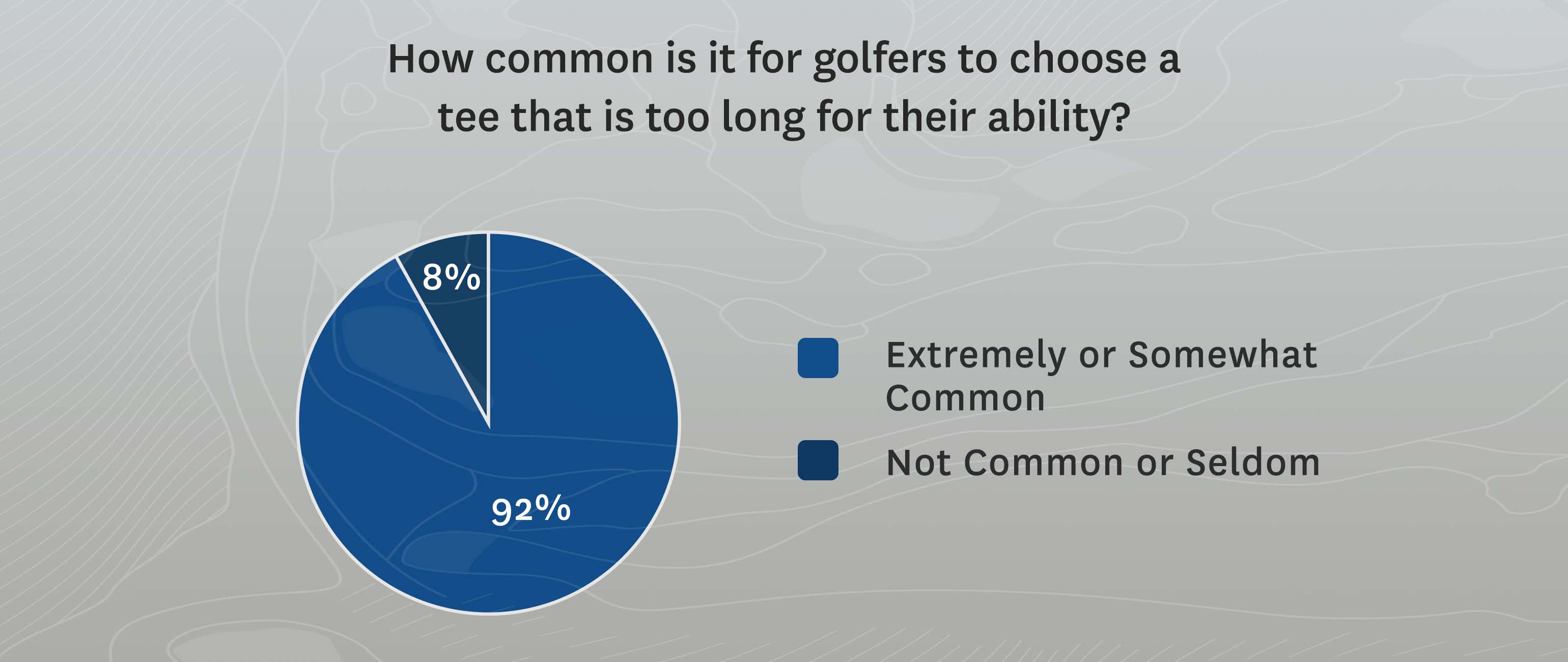
Results from a survey of 742 PGA and LPGA professionals (USGA/PGA-LPGA, 2021-22)
-
What are the best tees for a golfer’s ability?
As we studied how to improve golfer decision-making when it comes to tee selection, we had to define what constituted a good fit between a golfer’s hitting distance and a teeing option. Working with our golf industry partners, we arrived at the following criteria: “A set of tees is a good fit for a golfer’s ability when it allows them to comfortably reach the fairway on par 4s and par 5s, reach the vicinity of most greens in regulation, and allows them to hit a variety of clubs on their approach shots.” Nearly all of the PGA and LPGA professionals that we surveyed agreed with this definition.
Our survey data showed that golfers prefer hole lengths that are proportional to their personal hitting distance. In simple terms, long hitters prefer longer holes and shorter hitters prefer shorter holes. Through the survey, golfers indicated when holes felt “too short”, “too long” and “reasonable” for par-3, par-4 and par-5 holes. The results were translated into the following desired approach club preferences:
- Par 3s feel too short when the tee shot is less than a gap wedge, too long when it requires more than a fairway wood, and they are about right at a 6-iron distance.
- Par 4s feel too short when they are less than a driver-gap wedge. They are too long when they exceed a driver-fairway wood and they are about right when they are driver-6 iron.
- Par 5s feel too short when they require a driver-fairway wood-medium pitch shot. They are too long when they exceed driver-fairway wood-6 iron and they are about right when they are driver-fairway wood-9 iron.
These preferences refer to holes in general. Clearly, many golfers enjoy the occasional driveable par 4 or drop-shot par 3. Indeed, some of the most famous holes in the world fall outside these average preferences. What this data shows is that golfers generally want to hit approach shots that are within their capabilities – even if they don’t always play from a tee that helps them achieve that goal!
"A set of tees is a good fit for a golfer’s ability when it allows them to comfortably reach the fairway on par 4s and par 5s, reach the vicinity of most greens in regulation, and allows them to hit a variety of clubs on their approach shots.”
Developing the “Best Tees” system
We combined our definition of tees that are a good fit for a golfer’s ability with golfers’ stated preferences for approach shot distances to develop a system that can recommend course length based off a single reference club. We chose a 7 iron because golfers had an accurate estimate of their hitting distance with this club in our golfer performance research and golf professionals often use this club as a point of reference during lessons. We came to call this system “Best Tees” and the table below shows the recommended par-72 course lengths for the average male and female golfer based on the average 7-iron distance for those players. The model course in this case is made up of four par 3s, ten par 4s and four par 5s. Based on hitting distance data collected from a range of sources, including our own field testing, the average 7-iron hitting distance for female golfers is 100 yards and the average 7-iron distance for male golfers is 138 yards. According to our “Best Tees” system, the average female golfer should play a tee about 4,400 yards and the average male golfer should play a set of tees about 6,100 yards. However, we all recognize that there are a wide range of golfers and courses out there, so the average is just a starting point. We wanted to develop an improved system for tee selection based off hitting distance and golfer preferences that would be fully customizable to any golfer at any course they play.
-
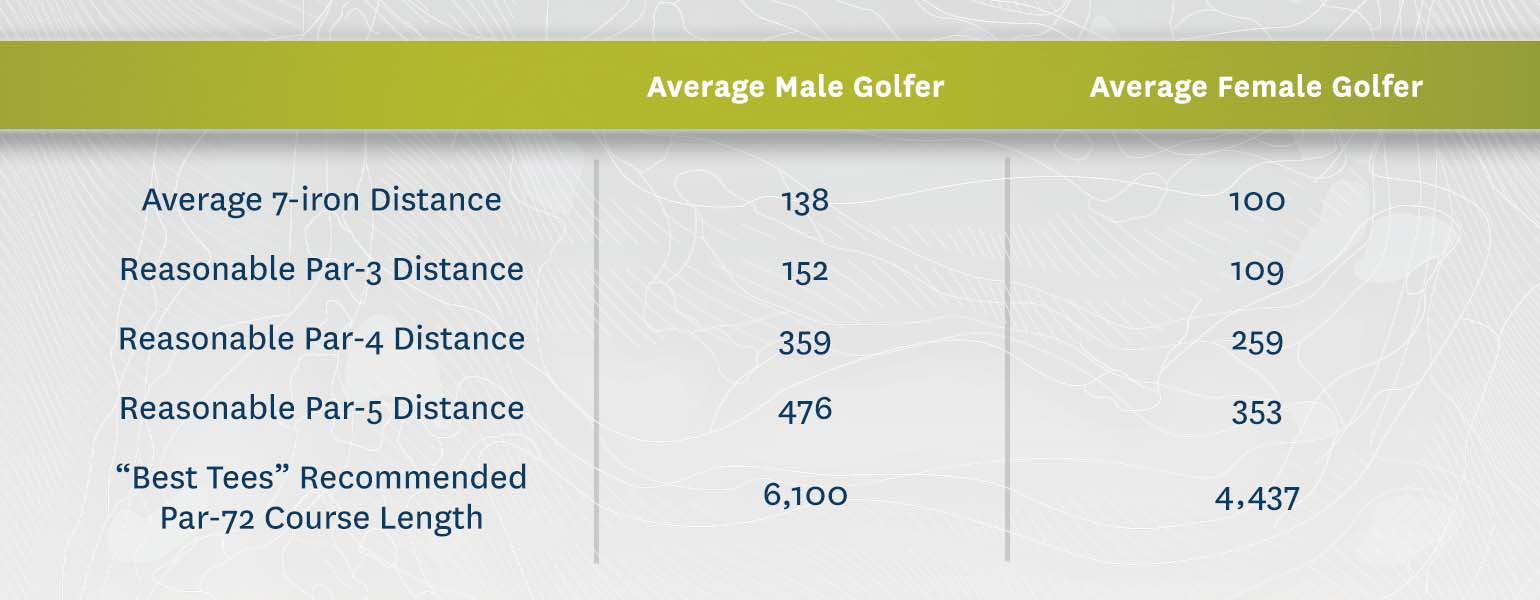
Based on golfer performance data and golfers’ stated preferences for approach shot lengths, these results show what constitutes a “reasonable” hole length and the total course length recommended by the “Best Tees” system for the average player in each group. All distances are in yards.
-
The American Society of Golf Course Architects (ASGCA), the National Golf Course Owners Association (NGCOA), the Golf Course Superintendents Association of America (GCSAA), the Golf Course Builders Association of America (GCBAA), the LPGA and PGA all partnered with the USGA to study the issue of golfer tee selection and develop a simple, yet flexible system to help golfers find the tee at any course that best fits their game. The “Best Tees” system is based on extensive golfer survey data, a variety of golfer hitting distance data sets, World Handicap System score posting and other data sources. These inputs have been analyzed and built into a model that uses 7-iron hitting distance to offer a tee recommendation for all golfers at all courses.
The recommendations of the “Best Tees” system are based on ranges of 7-iron hitting distance. We studied the possibility of including more clubs in the system and found that while the recommendation would be slightly more accurate, the system would be considerably more complicated to use. To develop customized recommendations for each course, calculations utilize the number of holes, hole pars and hole lengths for each available tee from the course’s current course rating data. Additional fine-tuning to account for elevation changes, doglegs, forced carries and other course playability characteristics may take place in the future.
-
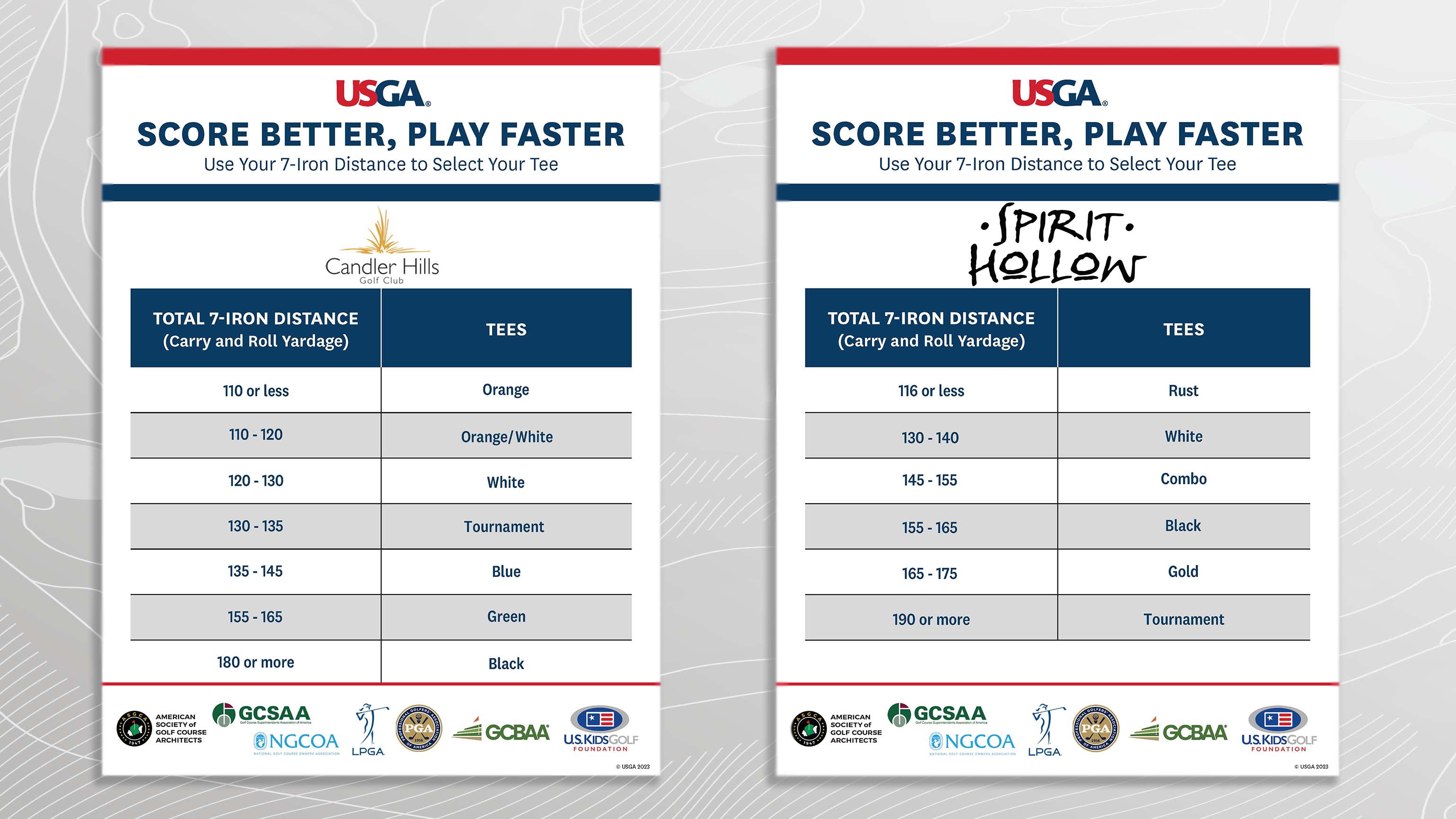
The “Best Tees” system is based on a golfer’s 7-iron distance and is fully customizable to every golf course. Golfers whose 7-iron distance falls between yardage ranges should decide which tee is best for their round. Moving forward is encouraged.
-
Helping golfers choose their “Best Tees”
In a recent survey, we asked golfers the following question: “If the golf course suggested a particular set of tees for me to use based on my skill level, and if it was different than where I typically play, would I follow that advice?” Fifty-three percent said yes! This increased to 59% when they were shown an early prototype of the “Best Tees” system. This willingness represents a substantial opportunity to improve golfer satisfaction and potentially pace of play at courses that implement the “Best Tees” system. However, engagement between facility staff and golfers is an essential driver of adoption and use.
In a survey of 119 NGCOA members, less than 20% said they had a “consistent system for making teeing recommendations to players.” However, 66% of that group said they would be “interested in having a system that allowed you to offer objective teeing recommendations to golfers based on their performance characteristics and the unique features of your course.” At the same time, 88% of the 742 PGA and LPGA professionals we surveyed said they would be interested in using a system that allowed knowledgeable staff to make tee recommendations to golfers based on objective player information like hitting distance. Implementing a system that staff can use to engage with golfers about their tee selection in the golf shop, during a lesson or at the starter’s building could help many players learn more about their game and make better teeing decisions for themselves or their group.
-
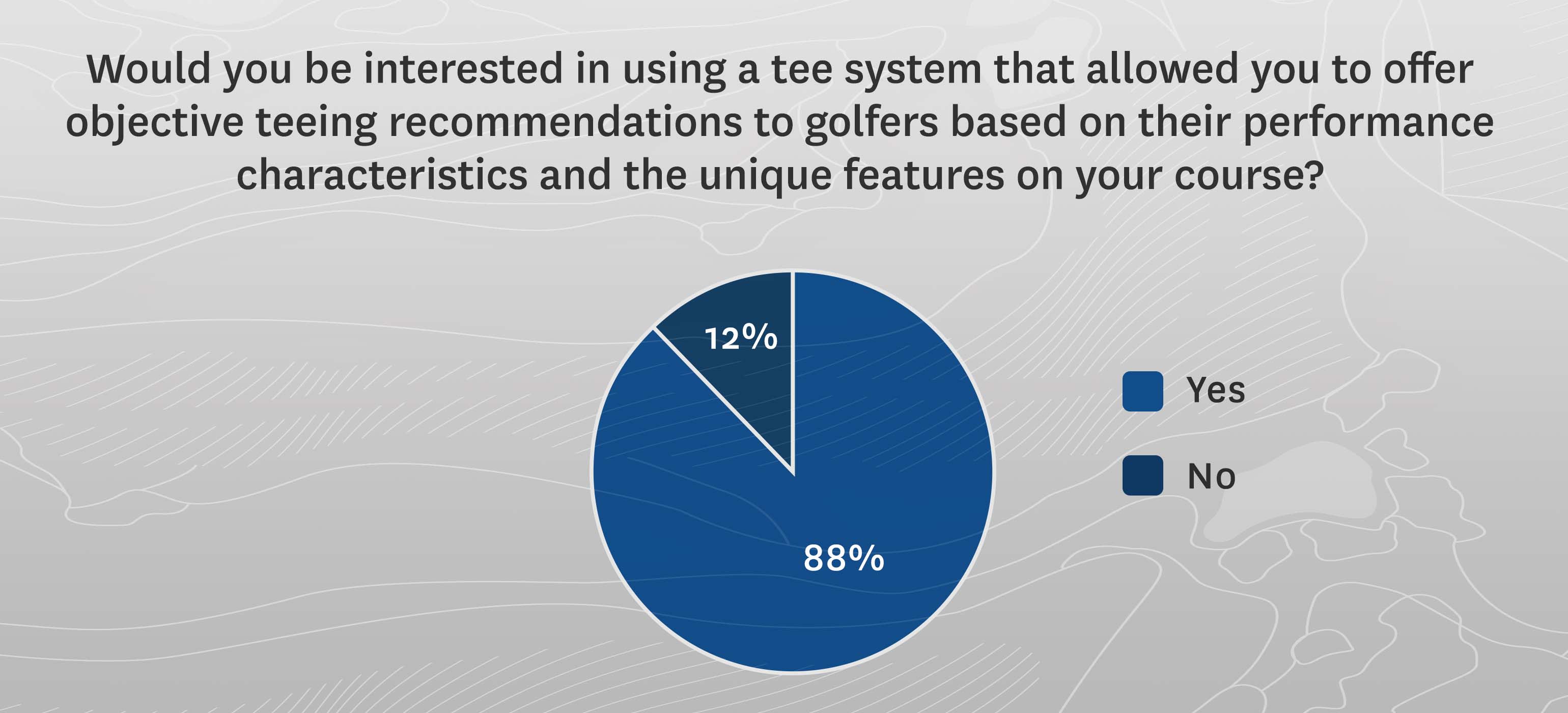
Results from a survey of 742 PGA and LPGA professionals (USGA/PGA-LPGA, 2021-22)
-
It is also critical for facilities to offer enough teeing options so that golfers can find one that is a good fit for their game. Our research shows that tees at approximately 3600, 4400, 5200, 6000, and 6800 yards – with combination tees about 400 yards between each physical set – will provide good options for 95% of golfers on an 18-hole course. Unfortunately, many courses do not have an adequate range of teeing options, especially on the shorter end of the distance spectrum. In the USGA article “Forward Tees for the Future” we highlighted the particular need for shorter forward tees at many facilities. Not only does this allow shorter hitters to play from a tee that works well for them, adding new forward tees can make it easier for other golfers who are currently playing from farther back to move forward.
Potential benefits of the “Best Tees” system
In our survey of 20,000 golfers, 85% said that playing a balance of shots during their round would have a “significant” or “extremely positive” impact on their round. Seventy-six percent either agreed or strongly agreed that it was important for them to experience the designed strategies of the course. Playing from a set of tees that allows you to hit a variety of approach shot clubs – and not always the longest clubs in your bag – is obviously a key part of achieving these goals. Ninety-nine percent of the PGA and LPGA professionals we surveyed said they felt golfers have a better experience when they play tees that are a good fit for their ability. The importance pace of play has when it comes to golfer satisfaction is also well known. Ninety-three percent of PGA and LPGA professionals that we surveyed believe pace of play improves when golfers play tees that fit their ability. Our modeling – and common sense – support that conclusion. Using the “Best Tees” system helps golfers achieve their own stated preferences for a round – hitting a variety of shots, experiencing the designed strategies of a course, and enjoying an improved pace of play.
-
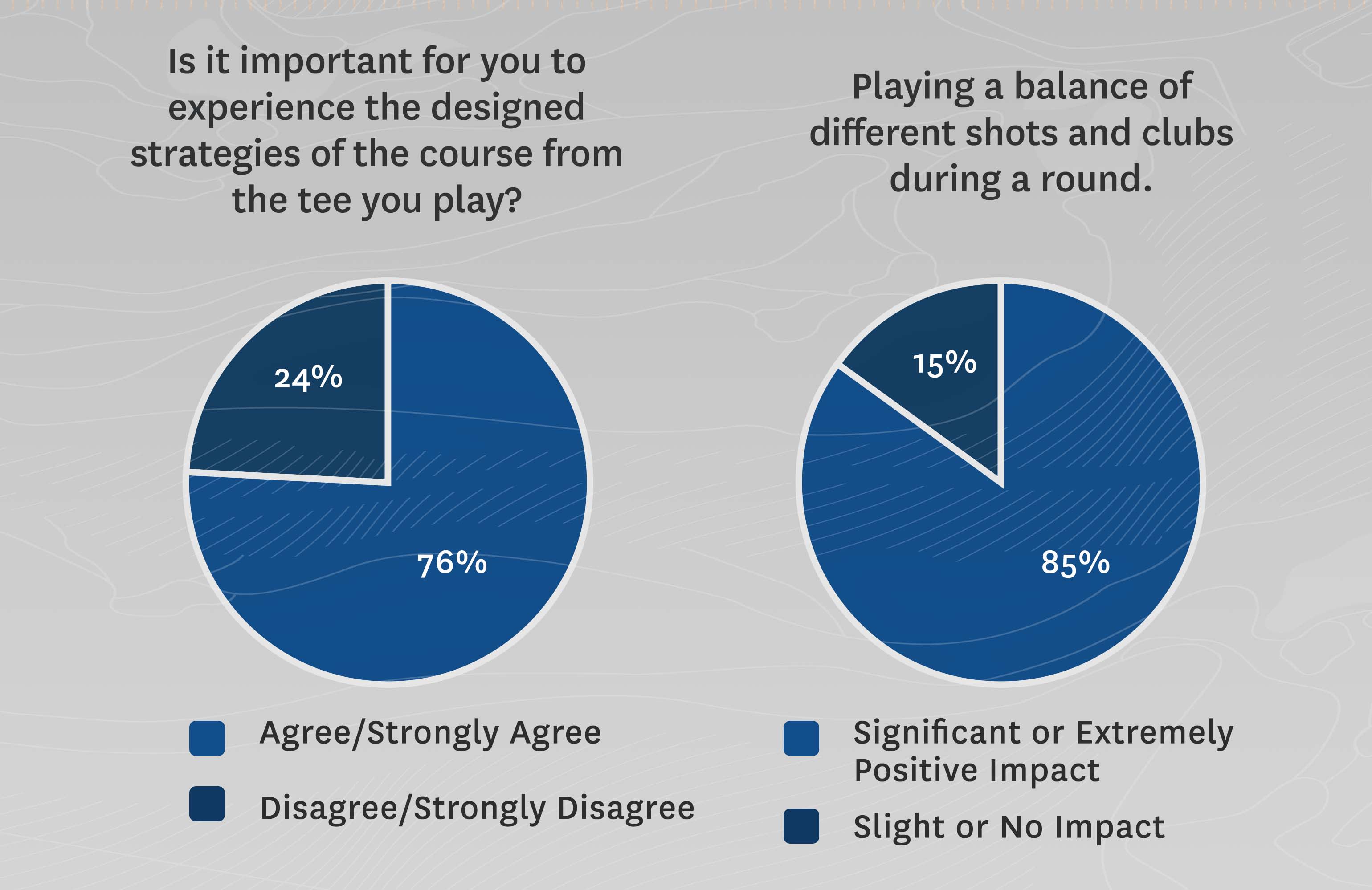
Results from a survey of 20,000 golfers. (SMS 2021)
-
The final analysis
The “Best Tees” system is based on multiple years of research that included golfer surveys, golfer performance testing and many other data points. It is being tested at over 60 courses across the United States in 2023. Feedback from this testing phase will be used to improve the system prior to broader distribution.
While golfers attest to the benefits of playing a tee that matches their ability, many do not select the best tees for themselves due to a lack of good options, a lack of understanding about their game, peer pressure and many other factors. Ideally, facilities will help remove some of these barriers by engaging with golfers to help them make better tee decisions for themselves and their group. Having each golfer play a tee that best fits their hitting distance is the ultimate goal. This gets a player off on the right foot. Using the “Best Tees” system doesn’t guarantee a fast round or a low score, but it removes significant obstacles that make it harder for players to have the golf experience that most say they want.